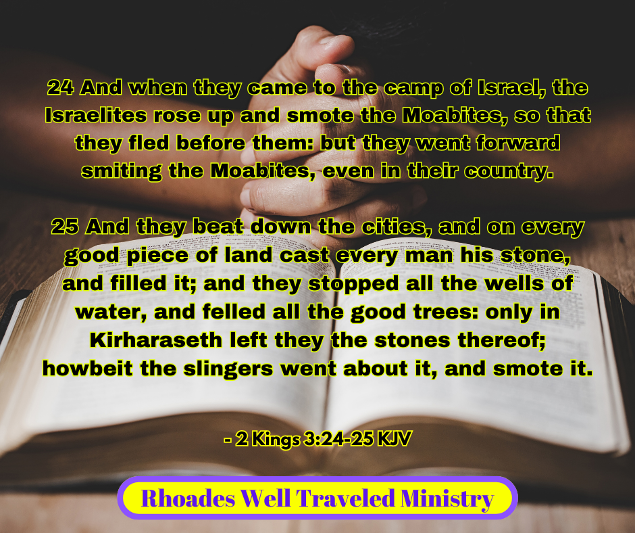GOD'S WORD
▬ The story of Mesha Stele in the KJV Bible ▬
March 22, 2024

Reverend Danny Rhoades
Brothers and Sisters, I'm doing something different over the next four days. I will be doing Part Two of my Four Part Series on "The Stories of Mesha Stele, Hadadezer and Sanballat I, in the KJV Bible. What rolls did they play in it and why were they important? I do hope the you will gain some great knowledge from them.
Today's devotional we will be delving into Part Two "The Story of Mesha Stele in the KJV Bible," and learn why he is an intriguing figure woven into the tapestry of the King James Version (KJV) Bible, each playing a distinct role in shaping the narratives of ancient times.
These historical characters offer insights into the political landscape, conflicts, and alliances of their era, providing valuable context for understanding the events depicted in the scriptures.
The Mesha Stele, a significant archaeological artifact from ancient Moab, holds a pivotal place in both biblical and historical contexts. This inscribed stone monument, dating back to the 9th century BCE, provides invaluable insights into the ancient Kingdom of Moab and its interactions with neighboring kingdoms, particularly Israel and Judah. Mentioned in the KJV Bible, the Mesha Stele's discovery and decipherment have sparked scholarly debates and shed new light on the complexities of ancient Near Eastern history. In this article, we delve into the story of the Mesha Stele, exploring its significance, biblical references, interpretations, and ongoing impact on biblical studies and archaeological research.
The Mesha Stele is an ancient inscribed stone monument that provides valuable historical information about the ancient kingdom of Moab. Discovered in 1868 in Dhiban, Jordan, the Mesha Stele is significant as it details the victories of King Mesha of Moab against the Israelites and provides insights into the political and cultural landscape of the region.
The kingdom of Moab, located east of the Dead Sea, was a powerful entity in the ancient Near East and engaged in conflicts with neighboring kingdoms.
The Mesha Stele sheds light on the complex relations between Moab, Israel, and Judah, highlighting military campaigns and territorial disputes between these ancient kingdoms.
The Mesha Stele's inscription narrates King Mesha's victories over the Israelites, his construction projects, and his dedication to the Moabite god Chemosh, offering a glimpse into the religious and political practices of the time.
This archaeological find is crucial for understanding the political dynamics and cultural practices of the ancient Moabites, as well as providing a valuable primary source for scholars studying this period.
While the Mesha Stele itself is not mentioned in the King James Version (KJV) of the Bible, its contents align with certain biblical accounts, offering a parallel perspective on events described in the Old Testament.
The Mesha Stele's mention of conflicts with the Israelites corresponds with biblical narratives, such as those found in the books of Kings and Chronicles, providing additional historical context to these biblical accounts. Interpretations and Controversies Surrounding Mesha Stele
Mesha Stele, an ancient artifact mentioned in the King James Version (KJV) Bible, has stirred up quite the scholarly commotion. Some say it's a historical gem, others think it's just a rock with an ego. Let's dig into the heated debates surrounding its interpretation.
Picture a group of academics arguing over ancient inscriptions like it's the hottest reality show. Some claim the Mesha Stele is a braggy victory monument, while others think it's a creative writing project gone wild. The clash of interpretations is juicier than a gossip column.
Oh, the drama! From disputed translations to questionable motives, the Mesha Stele has more scandalous elements than a tabloid magazine. Some say it's a historical treasure trove, while others suspect it's a sneaky forgery. It's like a soap opera set in ancient times.
Hold onto your academic hats, folks, because the Mesha Stele isn't just a dusty relic—it's a game-changer in biblical studies. Let's unravel how this ancient slab of stone has rocked the scholarly boat.
Archaeologists and biblical scholars are like detectives piecing together a historical puzzle, and the Mesha Stele is a crucial piece. Its inscriptions shed light on ancient civilizations, making scholars giddy with excitement. It's like unlocking a secret level in a video game, but with more tweed jackets.
Forget boring textbooks—studying the 99999 is like time-traveling to the ancient Near East. It's a crash course in kings, conquests, and quirky inscriptions. Thanks to this ancient artifact, we get a front-row seat to the drama of bygone civilizations. Who needs Netflix when you have Mesha Stele?
Fasten your seatbelts, because the Mesha Stele isn't done making waves. Modern research and technology are giving this ancient artifact a fresh makeover. Let's dive into the cutting-edge world of Mesha Stele studies.
Researchers aren't ready to close the book on the Mesha Stele just yet. They're like detectives with magnifying glasses, scrutinizing every angle of this ancient enigma. New discoveries and fresh interpretations keep the scholarly community buzzing like caffeinated bees. It's like a never-ending treasure hunt, but with more academic citations.
Move over, Indiana Jones—technology is the new hero in Mesha Stele studies. From laser scanning to 3D modeling, researchers are using cutting-edge tools to unveil the secrets of this ancient artifact. It's like giving the Mesha Stele a high-tech makeover, turning it from a dusty relic into a digital superstar. Who knew rocks could be so high-tech?In conclusion, the Mesha Stele stands as a remarkable testament to the rich history and cultural heritage of the ancient Near East. Its inscription not only provides vital historical information but also prompts us to reexamine our understanding of biblical narratives and ancient civilizations. As ongoing research and discoveries continue to unravel the mysteries surrounding the Mesha Stele, this ancient artifact remains a compelling link to the past, offering a glimpse into the complexities of a bygone era that continues to fascinate scholars and enthusiasts alike.
These historical characters offer insights into the political landscape, conflicts, and alliances of their era, providing valuable context for understanding the events depicted in the scriptures.
The Mesha Stele, a significant archaeological artifact from ancient Moab, holds a pivotal place in both biblical and historical contexts. This inscribed stone monument, dating back to the 9th century BCE, provides invaluable insights into the ancient Kingdom of Moab and its interactions with neighboring kingdoms, particularly Israel and Judah. Mentioned in the KJV Bible, the Mesha Stele's discovery and decipherment have sparked scholarly debates and shed new light on the complexities of ancient Near Eastern history. In this article, we delve into the story of the Mesha Stele, exploring its significance, biblical references, interpretations, and ongoing impact on biblical studies and archaeological research.
Brothers and Sisters now let's review what we just learned, from today's devotional.
First, where is the Mesha Stele mentioned in the KJV Bible? The Mesha Stele is not directly mentioned in the King James Version (KJV) Bible. However, its content aligns with an episode described in the Bible’s Books of Kings (specifically 2 Kings 3:4–28). This biblical account parallels, with some differences, the events recorded on the stele. The inscription provides valuable insights into the political relationship between the ancient Kingdom of Moab and Israel during the 9th century BCE1.
Second, what does the Mesha Stele reveal about the ancient Kingdom of Moab? The Mesha Stele, dating back to around 840 BCE, contains a significant Canaanite inscription attributed to King Mesha of Moab. In this inscription, Mesha details his victories over the kingdoms of Israel and Judah. Here are some key points from the stele:
- Mesha’s father ruled Moab for thirty years, and Mesha succeeded him.
- The stele describes how Chemosh, the god of Moab, saved Mesha from Israelite oppression.
- Mesha recounts battles, including capturing cities like Nebo and Yahaz.
- The stele mentions the restoration of Moabite lands and the construction of various structures.
- It also bears the earliest certain extrabiblical reference to the Israelite god Yahweh2.
Third, how has the discovery of the Mesha Stele impacted biblical studies? The Mesha Stele is a cornerstone of Semitic epigraphy and provides invaluable information:
- It offers insights into the Moabite language, culture, and political dynamics of the time.
- The stele’s reference to the “House of Omri” (Israel) is the most extensive inscription ever recovered related to Israel during that period.
- It contains the earliest certain extrabiblical mention of the Israelite god Yahweh.
- Scholars have debated its authenticity, but most biblical archaeologists consider it genuine and historical.
Fourth, are there any controversies surrounding the interpretation of the Mesha Stele’s inscription?
Some scholars have noted an inconsistency between the Mesha Stele and the Bible regarding the timing of the rebellion. The stele refers to Omri’s “son”, which some interpret as Ahab, while the Bible places the revolt during the reign of Jehoram of Israel, Omri’s grandson.
remains profound and continues to be a subject of scholarly exploration5.
Additionally, there have been debates about the stele’s authenticity over the years. However, the majority of experts today regard it as genuine and historically significant.
In summary, the Mesha Stele provides a unique window into the ancient world, shedding light on historical events, language, and the complex interactions between neighboring kingdoms during the Iron Age. Its impact on biblical studies remains profound and continues to be a subject of scholarly exploration.
In conclusion, these historical characters offer insights into the political landscape, conflicts, and alliances of their era, providing valuable context for understanding the events depicted in the scriptures.
The Mesha Stele, a significant archaeological artifact from ancient Moab, holds a pivotal place in both biblical and historical contexts. This inscribed stone monument, dating back to the 9th century BCE, provides invaluable insights into the ancient Kingdom of Moab and its interactions with neighboring kingdoms, particularly Israel and Judah. Mentioned in the KJV Bible, the Mesha Stele's discovery and decipherment have sparked scholarly debates and shed new light on the complexities of ancient Near Eastern history. In this article, we delve into the story of the Mesha Stele, exploring its significance, biblical references, interpretations, and ongoing impact on biblical studies and archaeological research.
Tomorrow I will go into Part Three of this four-part series, "The Story of Hadadezer and its significance."
Brothers and Sisters, I hope and pray that you have enjoyed and gained some great knowledge reading my devotional today on "The story of Mesha Stele in the KJV Bible." What roles did they play in it and why were they important" as I have researching and writing about them.
As you continue your journey of faith, I would love to hear from you, so I'm inviting you to join me in my ministry "Rhoades Well Traveled Ministry," and share your passion for spiritual growth and service, with me.
May we carry the light of compassion, the strength of faith, and the warmth of community with us as we step out into the world. Have a great and blessed day ahead. Amen.
Reverend Danny Rhoades


Dear Heavenly Father, we come before you today to lift up humanity as a whole, seeking your love, guidance and protection. As we reflect upon the story of Mesha Stele in the Bible, we are reminded of the struggles and conflicts that have plagued mankind since the beginning of time.
We ask for your forgiveness for the times when we have failed to live in harmony with one another. We pray that you would grant us the wisdom and understanding to see beyond our differences and to embrace our common humanity.
We also pray for your healing upon our world, especially in areas where there is war, poverty, and injustice. May your love and mercy touch the hearts of those in power and bring about lasting peace and justice for all.
Help us to learn from the lessons of the past and to strive for a better future for all of us. Give us the strength and courage to overcome the challenges that lie ahead, and to work together for the greater good.
We thank you for your unfailing love and for the gift of reconciliation through your son, Jesus Christ. May we always remember to love one another as you have loved us. These things I pray in the name of our Lord and Savior, Jesus Christ. Amen
I am Mesha, son of Chemosh-gad, king of Moab, the Dibonite. My father reigned over Moab thirty years, and I have reigned after my father. And I have built this sanctuary for Chemosh in Karchah, a sanctuary of salvation, for he saved me from all aggressors, and made me look upon all mine enemies with contempt.
Join us in spreading God's love and compassion to those in need.



